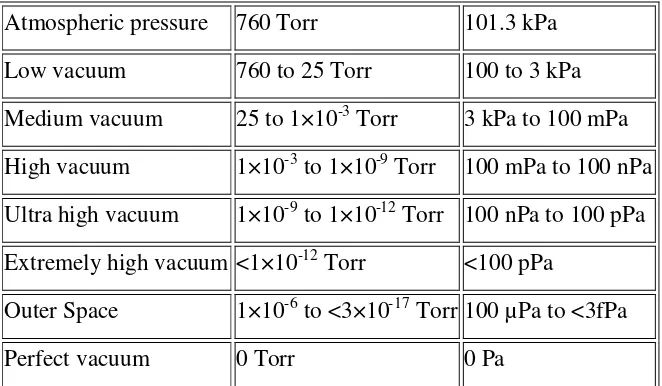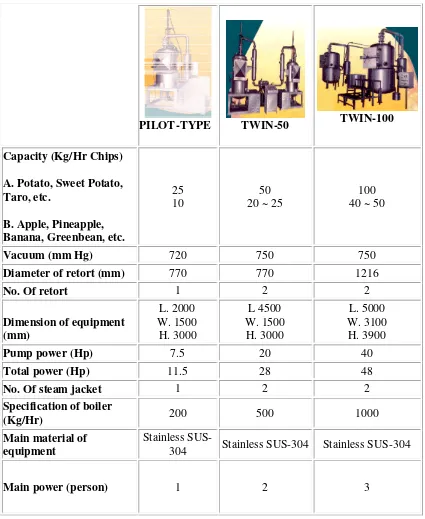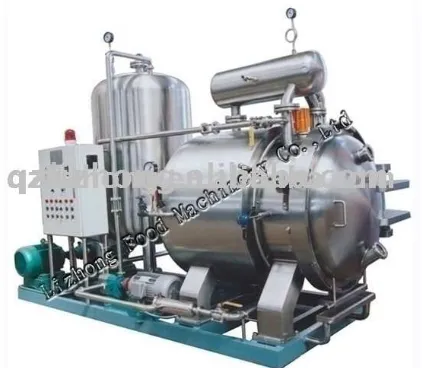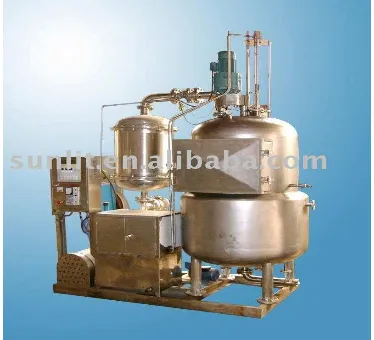STUDY ON PERFORMANCE OF VACUUM FRY DRYING SYSTEM
SAQINAH BINTI BAKRI
‘I / we* admit that have read this work and in opinion of me / we* this work was
adequate from the aspect scope and quality to the significance to awarded\ Bachelor Degree of Mechanical Engineering (Structure & Material)’
Signature :………
1stSupervisor Name :Prof. Madya Ir. Mustafa Ab. Kadir
Date :………
Signature :………
2ndSupervisor Name :Pn Norasra bt A. Rahman
STUDY ON PERFORMANCE OF VACUUM FRY DRYING SYSTEM
SAQINAH BINTI BAKRI
This report is submitted as partial fulfillment of the requirement for the award of Bachelor’s Degree of Mechanical Engineering
(Structure & Material)
Faculty of Mechanical Engineering Universiti Teknikal Malaysia Melaka
ii
“I declare that all part of this report are the results of my own work except for a few section which extracted and quoted from other resources that as been mentioned”
Signature :……….
Author :Saqinah Binti Bakri
iii
My immense gratitude goes to ALLAH S.W.T, the most merciful and gracious. Thank you to my parents, friends and supervisor Prof Madya Ir. Mustafa Ab. Kadir
iv
ACKNOWLEDGEMENT
ALHAMDULILLAH, I would like to thank Allah S.W.T for goodness and grace that sustained me throughout this crucial time in completing this major task in “Projek Sarjana Muda” entitled STUDY ON PERFORMANCE OF VACUUM FRY DRYING SYSTEM.
I would like to take this opportunity deliver my special thanks to my supervisors, Prof. Madya. Ir. Mustafa Ab. Kadir and Pn Norasra bt A. Rahaman for the support and advises throughout this semester. The opportunity and exposure extended to me through this project will be develop the skills and the self esteem in me as the preparation in the working environment.
I also take this opportunity to say thanks to all of every single person that helps me in any kind of help in my way to finish up my project. Last but not least, Thanks to give me this valuables moments I ever go through in my lives that had develop me as a student and also as a person.
v
ABSTRACT
vi
ABSTRAK
vii
CONTENTS
CHAPTER ITEMS PAGES
DECLARATION ii
DEDICATION iii
ACKNOWLEDGEMENT iv
ABSTRACT v
ABSTRAK vi
CONTENT vii
LIST OF TABLE xii
LIST OF FIGURE xiii
LIST OF ABBREAVIATION xv
CHAPTER 1 INTRODUCTION 1
1.1 Background 1
1.2 Problem statement 2
1.3 Objective 2
1.4 Scope 2
x
CHAPTER 2 LITERATURE REVIEW 3
2.0 Introduction 3
2.1 Vacuum 3
2.2 Fry dry 9
2.3 Vacuum frying processing 24
2.4 Pressure 25
2.5 Heating process 26
CHAPTER 3 METHODOLOGY 30
3.1 Method flow 30
3.2 Overview 31
3.3 Research method 32
3.4 Usage software
3.5 Design Process 37
CHAPTER 4 CONCEPTUAL DESIGN 39
4.1 Introduction 39
4.2 Choosing the best conceptual design 39
4.3 Concept selection 45
4.4 Final sketch 47
CHAPTER 5 DETAIL DESIGN 48
5.1 Detail drawing 49
5.2 Theoretical calculation 50
5.3 Material selection 52
CHAPTER 6 ANALYSIS AND RESULTS 55
6.1 Analysis 55
xi
CHAPTER 7 DISCUSSION 67
7.1 Analysis and Result 67
7.2 Theoretical result for comparison 68
CHAPTER CONCLUSION AND RECOMMENDATION 69
8.1 Conclusion 69
8.2 Recommendation 70
REFERENCES 71
xii
LIST OF TABLE
NO. TITLE PAGE
2.1 The vacuum range 5
(Source: http://en.wikipedia.org/wiki/Vacuum, (2008))
2.2 Vacuum fryer type 6
(Source: http://www.taiwan-agriculture.org/itung/itungpro.html (2008))
2.3 Frying conditions for the transient changes analysis 11 (Source: Yamsaengsung, R. and Ngamnuch, M. (2005))
4.1 The morphology chart 40
4.2 The decision matrix 46
xiii
LIST OF FIGURE
NO. TITLE PAGE
2.1 ZYZ-16-B Vacuum Fryer 7
(Source: http://www.alibaba.com/, (2008))
2.2 LTFM-I Vacuum Fryer 8
(Source: http://www.alibaba.com/, (2008))
2.3 Schematic diagram of the 400 L pilot-scale vacuum fryer 11 (Source: Yamsaengsung, R. and Ngamnuch, M. (2005))
2.4 Transient changes in vacuum pressure during frying 12 (Source: Yamsaengsung, R. and Ngamnuch, M. (2005))
2.5 Transient changes in oil temperature during frying 13 (Source: Yamsaengsung, R. and Ngamnuch, M. (2005))
2.6 Transient changes in vapor temperature leaving the fryer 14 (Source: Yamsaengsung, R. and Ngamnuch, M. (2005))
xv
2.8 Average transient changes in frying oil temperature, 16 vapor temperature leaving the fryer, cooling water temperature
exiting the condenser, and vacuum pressure
(Source: Yamsaengsung, R. and Ngamnuch, M. (2005))
2.9 Predicted and observed values of moisture ratio in 20 non-pretreated taro slices during vacuum frying at various temperatures (Source: Jamradloedluk, J. and Sappaso, S. (2008))
2.1.0 Influence of pretreatment on moisture reduction profile 21 of taro slices under vacuum frying at temperature of 160oC
(Source: Jamradloedluk, J. and Sappaso, S. (2008))
2.1.1 Lightness values of fresh taro slices during vacuum frying 22 at different frying times and temperatures
(Source: Jamradloedluk, J. and Sappaso, S. (2008))
2.1.2 Redness values of fresh taro slices during vacuum frying at 22 different frying times and temperatures
(Source: Jamradloedluk, J. and Sappaso, S. (2008))
2.1.3 Yellowness values of fresh taro slices during vacuum frying 23 at different frying times and temperatures
(Source: Jamradloedluk, J. and Sappaso, S. (2008))
2.1.4 Hardness of fried taro chip produced by different pretreatment 24 and frying periods (moisture contents of 1-3% d.b.)
(Source: Jamradloedluk, J. and Sappaso, S. (2008))
2.1.5 The LPG container 28
xvi
3.1 Method flow 30
3.2 The vacuum frying apparatus 33
3.3 Vacuum frying machine 34
4.1 Concept 1 41
4.2 Concept 2 42
4.3 Concept 3 43
4.4 Concept 4 44
4.5 The final sketch of the selected concept 47
6.1 The temperature effect on stress distribution in vessel 60
6.2 The displacement effect on stress distribution in vessel 61
6.3 The strain effect on stress distribution in vessel 62
6.4 The temperature effect on safety of factor of vessel 63
6.5 The pressure effect on stress distribution in vessel 64
6.6 The displacement effect on stress distribution in vessel 65
xvii
LIST OF ABBREVIATIONS
Torr = torr
k = kilo
Pa = Pascal
m = mili
n = nano
kg = kilogram
hr = hours
mmHg = millimeter of mercury
Hp = horsepower
M = mega
USA = United State of America
cm = centimeter
oC = degree Celsius
mL = milliliter
LPG = liquid propane gas
1
CHAPTER 1
INTRODUCTION
This chapter consists of the background of the project and its problem statement which followed by the objectives, scope and its organization.
1.1 Background
Nowadays, the demand for cooking equipment that can cook a desired food without losing the real taste, smell and color of the food has become the top priority in the food industries. The quality of the food can be maintained by using vacuum fry-drying system or vacuum frying technology. Basically, vacuum frying is a suitable processing method for the production of high quality crispy fruit chips. The vacuum frying technology produces crispy fruit chip with original color and fruit aroma and an ideal crispy texture.
2
1.2 Problem statement
The traditional cooking or specifically frying uses excessive heat which in the end burn the fibres of fruit or vegetables. To control this situation, there is need to utilize vacuum principle to reduce the heat in frying. In addition, to be able to control the situation the reliable design of vessel for vacuum frying must be obtained.
1.3 Objective
The objective of this project is to develop and design a lab scale vacuum fry-drying system and test the performance of frying-fry-drying vessel.
1.4 Scope
These projects cover the literature survey of fry-drying process and design the vacuum vessel and the theoretical performance of the vacuum vessel.
1.5 Organization
3
CHAPTER 2
LITERATURE REVIEW
2.0 Introduction
Literature review is the most important step to retrieve information’s related to the topic chosen. It can be done by searching the information from internet, journals, books and other sources such as attending any seminars or courses offered outside or inside the university. It is important to make a study or research on the system before starting any development. This is to gain knowledge on the system and to ensure this project is within its scope. This chapter will elucidate on the details of the process and technology involved in this vacuum fry-drying system.
2.1 Vacuum
4
Physicists often discuss ideal test results that would occur in a perfect vacuum, which they simply call "vacuum" or "free space" in this context, and use the term partial vacuum to refer to real vacuum [1].
The quality of a vacuum refers to how closely it approaches a perfect vacuum. The residual gas pressure is the primary indicator of quality, and is most commonly measured in units called torr, even in metric contexts. Lower pressures indicate higher quality, although other variables must also be taken into account. Quantum theory sets limits for the best possible quality of vacuum, predicting that no volume of space can be perfectly empty. Outer space is natural high quality vacuum, mostly of much higher quality than can be created artificially with current technology. Low quality artificial vacuums have been used for suction for many years [1].
In quantum mechanics, the vacuum is defined as the state with the lowest energy. To first approximation, this is simply a state with no particles, hence the name. However, even an ideal vacuum; thought of as the complete absence of anything, will not in practice remain empty. Consider a vacuum chamber that has been completely evacuated, so that the particle concentration is zero. The walls of the chamber will emit light in the form of black body radiation. This light carries momentum, so the vacuum does have radiation pressure. This limitation applies even to the vacuum of interstellar space [1].
5
Atmospheric pressure 760 Torr 101.3 kPa Low vacuum 760 to 25 Torr 100 to 3 kPa Medium vacuum 25 to 1×10-3Torr 3 kPa to 100 mPa High vacuum 1×10-3to 1×10-9Torr 100 mPa to 100 nPa Ultra high vacuum 1×10-9to 1×10-12Torr 100 nPa to 100 pPa Extremely high vacuum <1×10-12Torr <100 pPa
Outer Space 1×10-6to <3×10-17Torr 100 µPa to <3fPa
[image:21.595.154.485.104.297.2]Perfect vacuum 0 Torr 0 Pa
Table 2.1: The vacuum range
(Source: http://en.wikipedia.org/wiki/Vacuum, (2008))
2.1.1 Vacuum fryer
6
2.1.2 Machine description
PILOT-TYPE TWIN-50 TWIN-100
Capacity (Kg/Hr Chips)
A. Potato, Sweet Potato, Taro, etc.
B. Apple, Pineapple, Banana, Greenbean, etc.
25 10
50 20 ~ 25
100 40 ~ 50
Vacuum (mm Hg) 720 750 750
Diameter of retort (mm) 770 770 1216
No. Of retort 1 2 2
Dimension of equipment (mm) L. 2000 W. 1500 H. 3000 L 4500 W. 1500 H. 3000 L. 5000 W. 3100 H. 3900
Pump power (Hp) 7.5 20 40
Total power (Hp) 11.5 28 48
No. Of steam jacket 1 2 2
Specification of boiler
(Kg/Hr) 200 500 1000
Main material of equipment
Stainless
SUS-304 Stainless SUS-304 Stainless SUS-304
[image:22.595.107.532.142.661.2]Main power (person) 1 2 3
Table 2.2: Vacuum fryer type
7
[image:23.595.213.424.145.329.2] ZYZ-16-B (China)
Figure 2.1: ZYZ-16-B Vacuum Fryer (Source: http://www.alibaba.com/, (2008))
Main technical parameter:
1. Inner diameter of frying pot: DN1000
2. Max. Worked pressure of sandwich structure: 0.27Mpa 3. Max. Worked temperature of sandwich structure: 140 4. Inner bowl vacuum degree: -0.098Mpa
5. Volume: 300L
6. Centrifugal Rotary Speed: 600rpm 7. Weight: 2200 kgs
8
[image:24.595.225.412.146.316.2] LTFM-I (China)
Figure 2.2: LTFM-I Vacuum Fryer (Source: http://www.alibaba.com/, (2008))
Parameter:
1. Model: LTFM-I
2. Tank diameter (mm): DN1000 3. Vacuum degree (MPa): -0.098 4. Steam pressure: 0.25-0.3 MPa 5. Oil Volume (L): 450 L
6. Centrifugal spinning speed (rpm): 300 7. Net weight (kg): 2,500



